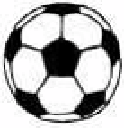Game Development Reference
In-Depth Information
Before we can come up with an equation that describes the force due to spinning, we need
to back up a bit and talk about an expression known as
Bernoulli's equation
. It is an equation
that relates the pressure,
p
, of a fluid to the kinetic and potential energy of the fluid.
1
---
rv
2
(5.27)
p
+
+
rgz
=
constant
In Equation (5.27),
r
is the fluid density,
v
is the velocity,
g
is gravitational acceleration, and
z
is the altitude of the fluid relative to some reference altitude (sea level, for instance).
Bernoulli's equation is useful for many different applications from flow rate meters to airfoil
design. One of the results that comes out of Bernoulli's equation is that if the altitude is constant
and the fluid velocity increases, the pressure will decrease. In Chapter 10, you will learn that
airplane wings generate lift because the fluid velocity is faster over the top surface of the wing
than it is over the bottom surface. The velocity difference between the top and bottom surfaces
causes a pressure difference that generates a lifting force on the wing.
Now let's apply Bernoulli's equation to the problem of an object that is spinning while
traveling through a fluid such as the soccer ball shown in Figure 5-14. The soccer ball is traveling
through with a velocity,
v
, and it is spinning counterclockwise with an angular velocity,
w
. When a
fluid travels over the surface of an object, the fluid that is right next to the surface sticks to the
surface. If the object is spinning, the fluid that is stuck to the surface of the object is pulled
along with the object in the direction of the spin. In the region close to the surface of the object,
the spin therefore adds to or subtracts from the fluid velocity. In Figure 5-14, the soccer ball is
spinning in the counterclockwise direction. The spin will increase the fluid velocity along the
top surface of the ball and decrease it along the bottom surface. Because the fluid velocity
along the top surface is greater than it is along the bottom, according to Bernoulli's equation
the pressure along the top surface of the soccer ball will be less than along the bottom. This
pressure difference will generate a positive lifting force.
v
w
w
v
Figure 5-14.
A spinning object generates lift.
Magnus Force
The phenomenon of a spinning object generating lift is known as the
Magnus effect
, some-
times also referred to as
Robin's effect
, and has been studied analytically and experimentally
since the 18th century. The direction of the force depends on the direction of the spin. If an
object is given backspin, the Magnus force will be in the positive vertical direction and will lift
the object up. If an object is given topspin, the resulting force will be in the opposite direction
and will push the object down.
















